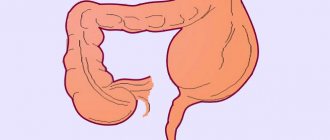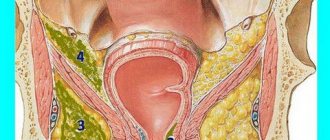It is important!
Most often, such manifestations are recorded in infants aged from several weeks to 4–5 months.
After that they disappear without a trace. The symptoms were best described by the famous American pediatrician, professor at the Yale School of Medicine Morris Arthur Wessel: “Colic is attacks of crying in a healthy child that last more than 3 hours in a row, more than 3 days a week, any of the last 3 weeks.” They are typical for breastfed or artificially fed infants. Statistics show that they appear more often in the evening. In many cases, they are combined with regurgitation and constipation. This aggravates the overall picture and gives parents additional anxiety. In addition to crying, manifestations of the onset of an attack include:
- the child's attempts to push,
- release of gases,
- hard bloated belly,
- pulling the baby's legs towards the stomach.
Colic in babies
The course of colic in infants can be isolated or combined with other functional digestive disorders (regurgitation and constipation). Causes of occurrence Despite the fact that the etiology of infant colic has not been reliably studied, the following provoking factors are identified: • errors in the nutrition of the nursing mother; • dysfunction of the gastrointestinal tract; • food intolerance to carbohydrates or proteins; • dysbiosis; • gastroesophageal reflux. The main clinical signs are persistent and loud crying, more often in the afternoon, agitation and irritation of the child, pulling up of the legs, bloating.
How to help your baby
First of all, the pediatrician must provide psychological support to the parents, explain to them the cause of colic, the symptoms, and how they can help the baby. In this case, it is important to support breastfeeding, correct the mother’s diet, and exclude foods that provoke flatulence: • mayonnaise; • peas; • fresh cucumbers; • beans, corn, etc. If the child is only on mixed or artificial feeding, then the selection of formulas should be carried out under the supervision of a pediatrician, taking into account concomitant pathologies. For food allergies (especially to milk protein), mixtures based on protein hydrolyzate, hypoallergenic, are prescribed; in case of colic and constipation - fermented milk and anti-reflux.
In order to relieve the baby's pain, it is recommended to follow the following steps: 1. Use physical methods: give the baby a special position (on his stomach or upright), cover him with a warm diaper or gently stroke his tummy. 2. Use products based on simethicone (Bobotik, Espumisan). Their appointment is justified in the presence of flatulence. 3. Pass gases by installing a gas outlet tube. 4. Relieve pain with antispasmodics and prokinetics.
Frequent misconceptions and mistakes of parents of infants in the treatment of constipation and colic
The appearance of constipation and episodes of anxiety in a baby always causes anxiety among parents, so the main task of the pediatrician is to calm them down and explain the situation. Unfortunately, not everyone seeks medical advice and medical help, but instead begins to use “time-tested” methods: • Not giving water to an infant is a common misconception. Supplementing with boiled water not only dilutes stool, but also prevents the development of cholestasis. • Cleanse the intestines with a decoction of beets, and often do cleansing enemas. In the first case, this is a prohibited product for up to a year, which can cause allergies and constipation; in the second, regular mechanical removal of feces causes intestinal hypotension and “washes out” all beneficial microflora. • Early introduction of complementary foods according to the principle “the earlier, the better.” However, the rules and timing for introducing complementary foods were created for a reason. The child’s immature body is not ready to assimilate the variety of food offered to it. • Change mixtures yourself. If the baby cannot tolerate one or another formula, you need to contact a pediatrician who will identify the cause and help you choose the most optimal one.
Causes
While the symptoms of intestinal colic are clear and have been described for a long time, the reasons for this behavior of the baby are not thoroughly known and cause disputes and disagreements among pediatricians around the world. There are several common myths about the appearance of such concerns, which are successfully debunked by leading experts. However, before making any recommendations, the doctor must rule out diseases that may cause colic. The main sources of their appearance include the following.
Immaturity of the gastrointestinal tract
. Many pediatricians consider this factor to be the determining factor. In support of their theory, they point to the fact that the newborn changes the way it eats (not through the umbilical cord). The intestines are also populated by new microflora.
Gastroesophageal reflux
. It is caused by acid from the stomach entering the esophagus and is manifested by physical discomfort. Most often this occurs in a horizontal position, so the baby suffers more if lying down and feels relief in an upright position.
Intestinal microflora disorders
(dysbiosis or dysbacteriosis). The theory is actively discussed and criticized. After all, the microflora in newborns is constantly changing, and this is considered the norm. In addition, the International Classification of Diseases does not include the diagnosis of “dysbiosis” at all. An argument in favor of the validity of this theory is the fact that children whose mothers take antibiotics suffer from colic more than others.
Lactose deficiency
. Occurs in a small (up to 1.5%) number of infants. If such a problem is identified, “lactose-free or protein hydrolyzate-based formulations will be effective.”
Features of the sucking process
. Incorrect attachment to the breast or a poorly selected nipple can cause the baby to swallow a large amount of air. This causes pain in the stomach. The baby may also choke on large amounts of breast milk and swallow air.
Increased psychological and physical sensitivity of the baby
. Some pediatricians put forward the theory that colic is not at all associated with gastrointestinal problems. In their opinion, this is a consequence of irritations that can be caused by various environmental factors: weather changes, wet diapers, loud sounds, bright lights, etc. In support of this theory, a number of studies were conducted by famous American pediatricians William and Martha Serz. They prove that a child with colic can be helped by methods not related to the impact on the gastrointestinal tract: carrying in the arms, rocking in a sling, etc.
Mom's emotional instability
. There is a theory that in a state of stress or during emotional disorders, the composition of breast milk changes, which leads to provoking attacks of colic in a newborn during breastfeeding.
Infant migraine
. Another unconfirmed point of view. It indicates the neurological nature of the origin of spasms. Scientists argue that colic can be considered a “companion” of headaches (migraines). After all, many people know that in a stressful situation a person experiences serious discomfort, including stomach pain. And colic occurs precisely during the period when the child realizes his separation from his mother. Also in favor of this theory is the fact that colic occurs and ends abruptly, without any apparent reason.
What are constipation and colic in infants, their differences
Colic and constipation in infants most often refer to functional disorders of the digestive tube (conditions in which there is no organic pathology). The causes of these disorders are due to dysfunction of the nervous system and the humoral part of the body, and not to damage to the gastrointestinal tract. So, infantile intestinal colic is understood as a condition of a child in which he becomes restless, irritable and begins to cry, and his face turns very red. These episodes last approximately 3 hours a day in total and occur at least three times a week. It is noteworthy that colic occurs and ends suddenly, for no apparent reason.
Constipation in newborns, as well as in infants, is a disruption of intestinal function in the form of chronic stool retention for at least 36 hours. This concept also includes an increase in the intervals between bowel movements, compared with the age and individual “norm”, and the passage of a small volume of feces of increased density.
Note. The normal frequency of stool for a healthy baby is from 2 to 6-8 times a day. However, do not panic if the child has bowel movements somewhat less frequently. At the same time, he passes feces of normal consistency for his age, and there are no behavioral disturbances.
Thus, infant colic and constipation are two different conditions that can occur together or in isolation from each other.
It is important!
To buy an effective mixture for colic and constipation, you should carefully study the composition.
The active ingredient is natural locust bean gum. It also helps in combating problems of excessive regurgitation. This component of the mixture has a double effect. It is an active prebiotic dietary fiber and thickener. Such features of locust bean gum make it possible to use antireflux mixtures if a newborn child has constipation and intestinal colic. Moreover, only natural components have similar characteristics. Instant (soluble) analogs have only a thickening effect - they are completely digested in the upper parts of the gastrointestinal tract.
Variety of offers from Nutrilak
Nutrilak Premium Antireflux
. The mixture was developed jointly with the Federal State Autonomous Institution “Scientific Center for Children’s Health” of the Ministry of Health of the Russian Federation. Its effectiveness in combating colic, regurgitation and constipation has been confirmed by clinical studies. It can be a complete replacement for one or more feedings per day. When breastfeeding, the mixture can be combined with breast milk. Premium Antireflux is a nutritional therapy, so you should consult your pediatrician before using it. He will determine the need to administer the mixture, dose and duration of use. This infant formula contains:
- carob bean gum
. It serves as food for beneficial bacteria in the colon and helps soften the food bolus as it passes through the digestive tract. This way, the intestinal microflora improves and regular bowel movements occur. As a result, reducing the likelihood of colic and constipation; - natural milk fat
. It is a source of energy for the active development of the baby. It also includes components that are necessary for good metabolism and proper brain development; - nucleotides
. Helps in the formation of the immune system and maturation of the gastrointestinal tract; - omega-3
. Fatty acids contribute to the normal development of the nervous system and visual acuity.
Fermented milk mixtures
. Dry formulations are easily digestible and, thanks to well-selected ingredients, help in the fight against digestive problems. Thus, Nutrilak Premium Fermented Milk is supplemented with the following complex:
- from bifidobacteria BB-12®, which help improve intestinal immunity and ensure regular soft stools;
- fermented protein, which facilitates absorption and improves digestion processes;
- lactobacilli L.rhamnosus LGG®. Probiotics are designed to eliminate gas formation and colic.
Constipation in an infant
During the first months of a baby’s life, the volume of his stomach begins to increase rapidly, and the intestines become populated with lacto- and bifidobacteria. This morphological and functional immaturity of the digestive tube contributes to slow passage of feces and excessive gas formation. This is due to the insufficiency of enzymatic processes, which leads to inadequate breakdown of nutrients
The most common causes of constipation in babies
In most cases, stool retention in children under one year of age is functional in nature, but it can also be a manifestation of a serious pathology. Among all the reasons, the most common: • Immaturity of the gastrointestinal tract due to cesarean section, use of medications during childbirth, unfavorable course of pregnancy (toxicosis, etc.). This contributes to the untimely development and maturation of the baby’s nervous system, which regulates intestinal functions. • Hypoxia suffered (in utero, during childbirth) also leads to impaired intestinal motility of the hyper- or hypotonic type in the newborn. This is manifested by stool retention as a result of weak contractility of the intestinal muscles or its spasm. • Imbalance of intestinal microflora. A decrease in the number of lactobacilli and bifidobacteria in some cases provokes constipation in infants. • Quick or early transition to artificial feeding. No modern formula is 100% capable of replacing breast milk, as it does not contain the required amount of enzymes, hormones, nutrients, and bacteria. Consequently, the child needs more time to adapt, which can also be manifested by stool retention. • Poor maternal diet and insufficient fluid intake. • Frequent changes of formulas, incorrect and untimely introduction of complementary foods, monotonous nutrition, underfeeding and the use of formulas containing large amounts of iron. Less commonly, organic pathology causes stool retention in infants: • Connective tissue dysplasia, rickets and hypothyroidism. They are accompanied by severe muscle hypotension, including intestinal muscles (do not forget that the listed diseases also have other clinical manifestations that are difficult to miss). • Food allergy, especially to cow's milk protein (in this case, swelling of the intestinal mucosa develops, its motility is impaired, and the functioning of the pancreas is affected). • Developmental anomalies of the large intestine (Hirschsprung's disease, dolichocolon, etc.). Note. Children in the first 2-3 months of life often experience dyschezia (a type of constipation). These are difficult acts of defecation, which are manifested by the baby crying and screaming for 15-30 minutes several times a day. After defecation, the child immediately calms down, and the feces have a soft consistency without any pathological impurities (blood, mucus, greens). This condition does not require treatment and usually goes away on its own by 6 months.
How to help your baby
In the absence of signs of organic pathology, stool retention is considered a functional disorder. Correction of constipation in infants should be comprehensive and include: • parental education; • prescription of rational diet therapy; • use of medications and mechanical means for bowel movement, if necessary. The pediatrician must clearly explain to the child’s parents that functional disorder is a common and harmless condition that disappears on its own over time.
It is also important to recommend that the mother of a baby continue breastfeeding for as long as possible (optimally up to 1.5 years) and correct her diet (include vegetable oil, foods containing dietary fiber and fiber; optimize the water regime). If a child has signs of a food allergy, a strict hypoallergenic diet is prescribed (dairy products and milk are excluded). If the baby is only bottle-fed, then it is better to use mixtures based on protein hydrolyzate and amino acids.
Note. In some cases, synbiotic preparations and mixtures (containing pre- and probiotics) help. However, the effect of them will be observed if there is a point of application - an imbalance of the intestinal microflora.
Sometimes it is advisable to use medicinal antireflux mixtures. They not only have a laxative effect, but also stop regurgitation. The latter appear due to the fact that gases accumulated in the intestines increase intra-abdominal pressure and irritate the diaphragm. Expert opinion. The most optimal and harmless mechanical method of bowel movement is considered to be irritation of the anus. Usually a clean ear stick is used. However, frequent use of this technique reduces its effectiveness. A cleansing enema should be the last resort in the treatment of constipation, as it causes addiction syndrome.
A few more tips instead of conclusions
Some experienced mothers know that not only a mixture for colic and constipation can be effective. You can also relieve spasms with:
- relaxing bath. After being immersed in warm water, the child usually calms down and stops crying;
- motion sickness in the arms. You can also use special devices;
- walks in the open air. As a rule, colic attacks occur at the same time. Get ready for your walk in advance. This will avoid unpleasant screams.
Health to you and your baby!










